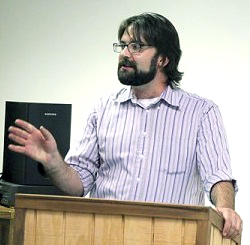Tim Riley and the museum

This archived article was written by: Mara Wimmer
At Utah State University Eastern, students can take many diverse classes. One of the classes offered at USUE is Anthropology 1010 which is taught by Tim Riley, the curator for the USUE prehistoric museum. Riley is an anthropologist mainly focused on paleoethnobotany, which is the study of how people used plants in the past.
“Paleo means old. Ethno is people, right? Ethnicity, ethnography. And then botany which is plants,” Riley said. “One of the best ways we can understand what people ate in the past, they ate mostly plants and animals, is by looking at their remains.
“I was an undergraduate who worked at a site in New Mexico. For my senior undergraduate thesis, I looked at plants from that site and how they used them. They were corn farmers but, they ate a lot of wild plants too. I thought that was neat and decided I am interested in substinance, I want to study how people made their food living in the past. So, paleoethnobotany was a good way to go about that.”
During his career Riley has traveled to many locations to work on or examine sites. “I have worked in Arizona, Nevada, New Mexico, Utah, Texas, Wisconsin, Iowa, Missouri, Indiana, Ohio and Michigan, that is it in the U.S. and in the American Somoas.
“If there is something like a pipeline or rail line, you might just be going through and identifying where a site is, in that situation I have worked on hundreds of sites. But, if you are going to go back and test it to see if it is eligible for the criteria under the law, I have worked on maybe a hundred sites around the U.S., maybe a couple more than that. And the full on, what they call data recovery or mitigation which would be like a complete excavation, would probably be along the order of fifty or so.”
Riley has been the anthropology professor three years and the curator at the museum for four years. The museum is a federal repository and an accredited museum that means it is required to have professionals on staff to take care of the collections. At the museum, there are about 60 exhibits and 15 dinosaurs on display; including one of the most complete mammoths in the Americas.
“A lot of my job is working with these collections,” Riley said. “Either doing research on them or maintaining them, checking the conditions and dealing with issues if they need repair or stabilization, accepting new collections found on federal land today.”
Along with his work at the museum and at the college, Riley is working on an active site in East Carbon. He is looking for students to volunteer and help on the excavation site.
“It is a house that was lived in a thousand years ago by people we call the Fremont,” Riley said. “The Fremont were corn farmers who lived at the same time as the more famous ancestors, the Pueblo. These people lived in smaller communities, sort of hamlets or farmsteads.
“The one I am looking at is basically what is called a ‘pit house.’ It is a structure that they dug partially into the ground and then roofed. I am always looking for students [to help] if they want to volunteer.”
Along with the opportunity to volunteer, Riley is looking for a student to intern with him. The intern would work with him on the excavation site through the summer and the next academic school year. The student will also be able to co-author a paper with Riley.
“They can contact me,” Riley said, “or stop by the museum. Students, faculty and staff all get in for free. So, you can always come in and say you are here to see Tim Riley and if I am around, I’d be able to see you. Or you can email me at [email protected] or at my office at 435.613.5290.”




